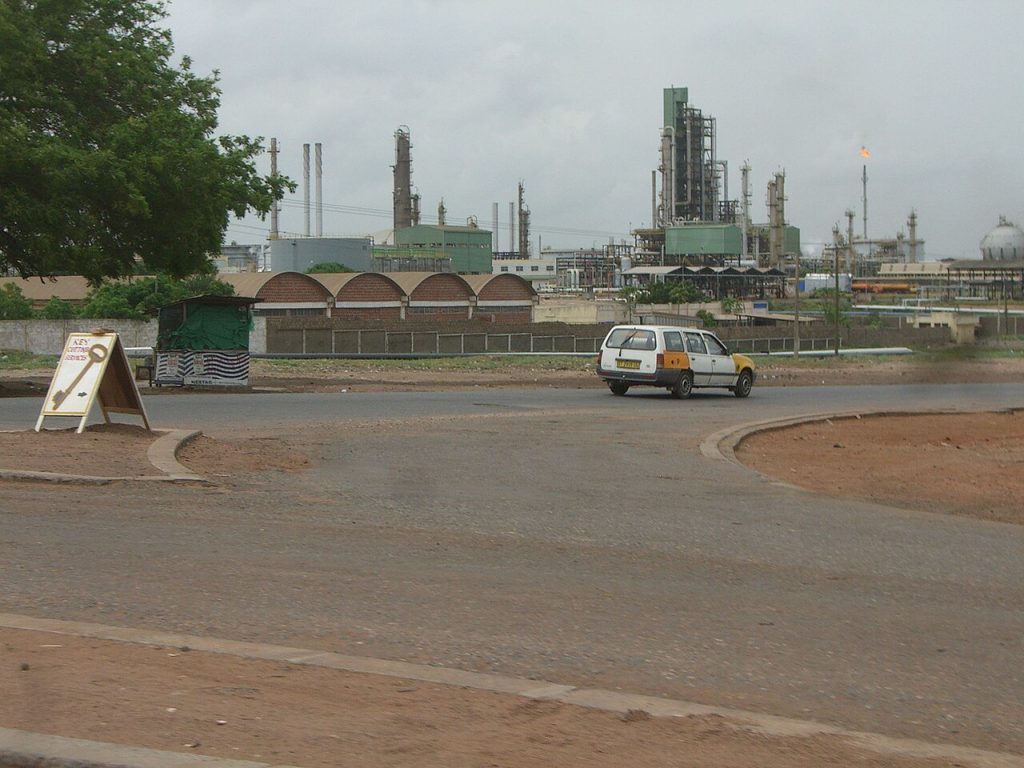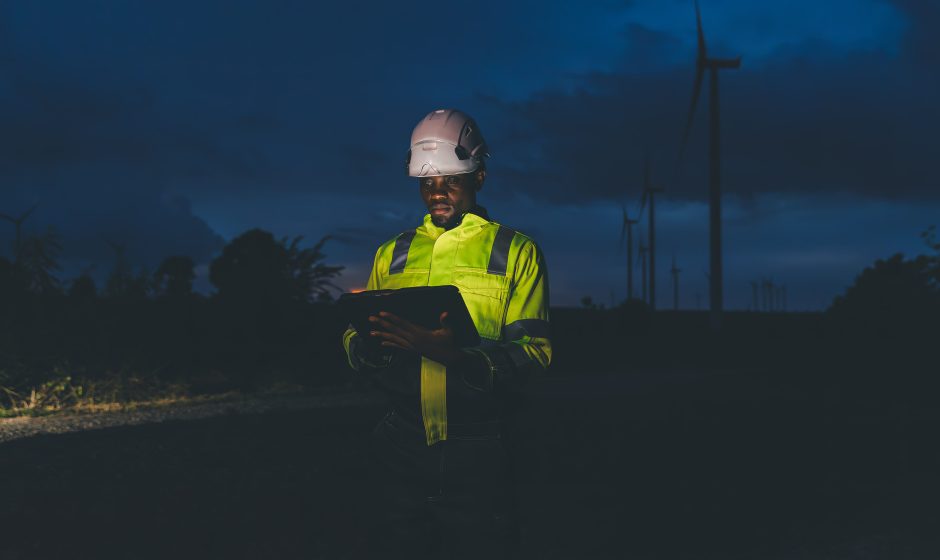Ghana’s power grid has been under strain, with frequent blackouts (often called “dumsor”) disrupting daily life. In late 2023 and early 2024, for example, Ghana experienced widespread outages – GRIDCo even reported a 550 MW supply shortfall at the Tema plant due to limited gas. Sustainable Energy for All notes that “significant power interruptions during 2024, commonly referred to as ‘dumsor’,” risk public health and economic stability. In short, aging plants, fuel shortages, unpaid energy debts and maintenance lapses have caused rolling power cuts. Critics cite unpaid bills to gas suppliers and poor infrastructure: one MP noted that GNPC stopped payments on the West African Gas Pipeline, grounding Tema’s plants and triggering load-shedding. Government and analysts call it load-shedding, but many Ghanaians still call it dumsor – and experts warn the energy sector is “extremely unhealthy” and in crisis.
Modern plants like Tema’s oil-and-gas generator (shown above) are key to Ghana’s power. When these plants run low on fuel or money, outages happen. A 2023 study found the grid on the brink of crisis, with a $1.7 billion inherited debt to power suppliers and rising deficits. Until the national supply stabilizes, households and businesses must rely on backup solutions.
Backup Generators: Pros and Cons
- Small Portable Generators (gasoline or inverter type): Affordable ($200–$500), compact units (~1–5 kVA) power essentials like lights, fans, and a fridge for short periods. Inverter models are quieter and more fuel-efficient. Pros: Low upfront cost and relatively easy to operate; Cons: Can only run limited devices and often consume ~$1 USD of fuel per hour per kW of output. They also emit fumes and are noisy. Maintenance (oil changes) adds cost. Good for emergencies or light-duty use by single users or small families.
- Large Standby Generators (diesel or petrol, 10–20 kVA+): Industrial-style generators (often $2,000+ USD for a 10–15 kVA unit) can power an entire home or business for hours. Pros: Capable of running heavy loads (AC units, multiple appliances) and can operate for long periods (diesel versions use less fuel per kW). Cons: High price and installation cost (transfer switches, wiring), significant noise and vibration, and require secure outdoor placement. Diesel fuel is bulkier but stores longer than gasoline. Larger generators suit families needing continuous power (fridge, fans, lights) or offices requiring uptime, but they are expensive and loud.
Solar Panels and Battery Backup
Solar power is a clean, silent alternative, though it needs a bigger investment. A basic off-grid kit (panels + charge controller + battery + inverter) can cost anywhere from $500 to several thousand USD depending on size. For example, a small DIY kit (100–200 W panels with a 100 Ah battery) might be ~$700–$1,500, while a professionally installed 1 kW system could be $2,000–$4,000.
- Portable Solar Generators (Power Stations): These combine a battery, inverter, and small solar panel(s) in one unit (e.g. Jackery or Goal Zero). They run for hours on a single charge (good for lighting, phone/laptop) and recharge by the sun. Pros: Zero ongoing fuel cost, silent, no fumes. Ideal for apartments or rentals where roof panels aren’t possible. Cons: Limited capacity (often <500 Wh) – not enough to run a fridge all night – and can be costly per kWh of storage (e.g. $500+ for a 500 Wh unit).
- Fixed Solar + Battery Systems: Roof-mounted panels charging deep-cycle batteries and feeding an inverter. Pros: Can power larger loads (multiple fans, lights, and possibly a fridge) during daylight and into the evening. Very low running cost once installed. Cons: High upfront cost (panels, batteries, inverter, installation). Battery replacements (lead-acid or lithium) are expensive and typically needed every 5–10 years. Also requires daylight to recharge; heavy cloud cover or many rainy days will limit output.
Businesses and some households in Ghana are increasingly adopting solar: by 2023, commercial and industrial customers had installed over 60 MW of captive solar PV to offset grid unreliability. If you can afford it, solar plus batteries can greatly reduce your electricity bills and provide clean power when the grid fails. However, remember that full coverage (including nights and cloudy days) can double the cost compared to a generator.

Inverters and UPS Systems for Short Outages
For brief outages (minutes to a couple of hours) or to protect electronics, smaller battery backups can help.
- UPS (Uninterruptible Power Supply): Typically used for computers and small electronics, a UPS contains a battery and inverter that gives seconds to minutes of power, just long enough to shut down safely or bridge a brief cut. Pros: Instant switchover, protects against data loss. Cons: Very short runtime, not useful for lights or appliances beyond a few minutes. Small UPS units cost $50–$200.
- Home Inverter Systems: Larger battery packs with an inverter (often called “solar inverter” even if grid-charged). These can keep lights, fans, and chargers running for 1–4 hours. For example, a 1–2 kW inverter with a 100 Ah battery (about $300–$600 total) might run 2–3 LED lights and a fan for several hours. Pros: Quieter and cleaner than a generator, no fuel needed. Cons: Limited power and duration; heavy batteries; added wiring. These are popular for home offices or remote workers who need to keep routers, modems, and PCs online during short cuts. For instance, a remote employee might use a $400 inverter/battery combo to power their computer and internet router each night, far cheaper than running a generator for the same.
Energy-Efficient Home Practices
Reducing demand can make any backup solution go farther. Simple efficiency measures can stretch limited power:
- LED Lighting: Replace incandescent or CFL bulbs with LEDs. An LED uses ~10W versus ~60W for the same light – quadrupling battery backup time. LEDs also reduce generator fuel usage.
- Efficient Appliances: Look for “5-star” rated fridges, fans, and electronics; they use far less power. A modern inverter refrigerator or energy-star fan will allow them to run longer on backup power.
- Unplug and Switch Off: Turn off devices and chargers when not in use (TVs, phone chargers, power strips). This “phantom load” saving can noticeably extend battery/generator runtime.
- Stagger Usage: Run big appliances (dishwasher, washing machine, water pump) during daylight or when the grid is on. Avoid using ovens or heaters on generator power if possible.
- Alternative Cooking: Gas stoves or charcoal/biogas can reduce reliance on electric hotplates during outages.
These steps cost little or nothing and improve comfort when power is tight. Energy savings also reduce monthly bills and system strain – for example, using LEDs and efficient fans might cut a home’s power needs in half, meaning a smaller generator or battery can handle evening use.
Choosing the Right Backup Setup
The best solution depends on your situation and budget:
- Remote Workers/Small Businesses: Prioritize keeping connectivity and computers live. A mid-size inverter + battery or a small generator (5–10 kVA) can keep offices running. Many also use UPS for computers and a separate generator for lights/fans when needed. The higher cost of reliable backup is often justified by uninterrupted work.
- Families with Kids: Refrigeration and comfort are critical. A larger generator (10 kVA+) or a hybrid system (solar panels + big batteries) can keep the fridge, fans/AC, and lights on. Expect to spend $1,000–3,000+ for a full home setup. Comfort is high, but so is cost. In contrast, a cheap portable generator only handles basics, so you must prioritize (e.g., run fridge or fan, not both at full blast).
- Ordinary Households or Renters: A small generator ($200–$500) or a basic solar power station might suffice for lights, phone charging, and a single fan. This keeps essentials going at a low cost, but will leave big appliances dark. Energy-efficient practices help here the most.
- Expats and Staff Housing: Often have resources for bigger systems – sometimes whole compounds install standby generators or complex solar + battery arrays for full reliability.
Each option is a comfort vs. cost trade-off. Generators give instant, full-power relief but cost more in fuel and maintenance. Solar and batteries save money long-term and are quiet, but you pay much more upfront and must plan usage. Small inverters/UPS are cheapest but only support a light load for a short time. Generally, the more children or people you have, the more robust (and expensive) your backup should be to keep food cool and the house livable.
Outlook: Ghana’s Energy Infrastructure
In the long run, Ghana is working to stabilize its grid. The government has inherited billions in energy sector debt (over $3 billion by late 2024), and officials acknowledge suppliers like Karpowership may shut plants without payment. This fragile situation means short-term outages may continue until debts are resolved. On the bright side, Ghana has policy goals for renewables and new capacity: a 2019 Renewable Energy Master Plan set a target of ~1,364 MW of solar/wind by 2030, though progress has been slow. The new Ministry of Energy and Green Transition suggests a push toward clean energy. Several solar farms and small hydro projects are in the pipeline, and reforms may improve billing and reduce losses.
For now, experts caution that blackouts will persist intermittently until these structural issues are fixed. In other words, backups will remain a practical necessity for Ghanaian homes and businesses. Residents can prepare by combining solutions: a small generator or inverter for immediate relief, solar panels to cut fuel use, and lifestyle changes to reduce demand. Over time, as more renewable projects come online and power purchase debts shrink, Ghana’s grid stability should improve. Until then, understanding the trade-offs of each backup option and planning accordingly is key to staying comfortable during dumsor.
Sources
- Africanews – “Limited gas supply triggers nationwide power outage in Ghana” (August 2023)
- Graphic Online – “Give us dumsor timetable – Armah Buah to GRIDCo” (January 2024)
- MyJoyOnline – “Power crisis to deepen as Karpowership threatens shut down” (May 2025)
- Sustainable Energy for All – “Country Brief – Sustainable Cooling for All in Ghana” (December 2024)
- Climate Policy Lab – “The Case for Ghana’s Renewable Energy Transition” (March 2025)
- International Renewable Energy Agency – Ghana Energy Profile (2024)
- Ghana Business News – “GNPC suspends payments on West African Gas Pipeline” (April 2024)



